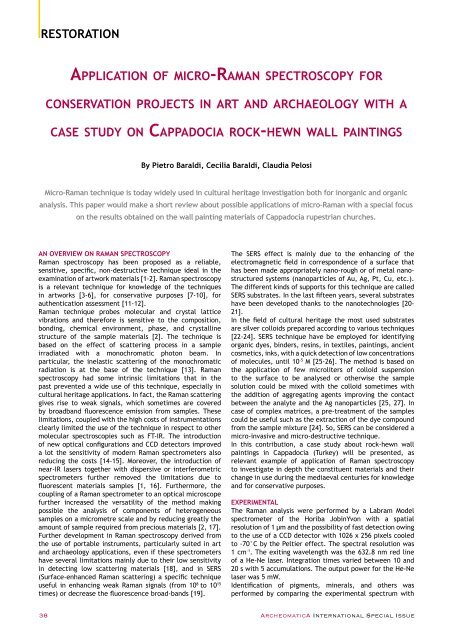Archeomatica International 2017
Special supplement to Archeomatica 3 2017
Special supplement to Archeomatica 3 2017
Create successful ePaper yourself
Turn your PDF publications into a flip-book with our unique Google optimized e-Paper software.
RESTORATION<br />
Application of micro-Raman spectroscopy for<br />
conservation projects in art and archaeology with a<br />
case study on Cappadocia rock-hewn wall paintings<br />
By Pietro Baraldi, Cecilia Baraldi, Claudia Pelosi<br />
Micro-Raman technique is today widely used in cultural heritage investigation both for inorganic and organic<br />
analysis. This paper would make a short review about possible applications of micro-Raman with a special focus<br />
on the results obtained on the wall painting materials of Cappadocia rupestrian churches.<br />
AN OVERVIEW ON RAMAN SPECTROSCOPY<br />
Raman spectroscopy has been proposed as a reliable,<br />
sensitive, specific, non-destructive technique ideal in the<br />
examination of artwork materials [1-2]. Raman spectroscopy<br />
is a relevant technique for knowledge of the techniques<br />
in artworks [3-6], for conservative purposes [7-10], for<br />
authentication assessment [11-12].<br />
Raman technique probes molecular and crystal lattice<br />
vibrations and therefore is sensitive to the composition,<br />
bonding, chemical environment, phase, and crystalline<br />
structure of the sample materials [2]. The technique is<br />
based on the effect of scattering process in a sample<br />
irradiated with a monochromatic photon beam. In<br />
particular, the inelastic scattering of the monochromatic<br />
radiation is at the base of the technique [13]. Raman<br />
spectroscopy had some intrinsic limitations that in the<br />
past prevented a wide use of this technique, especially in<br />
cultural heritage applications. In fact, the Raman scattering<br />
gives rise to weak signals, which sometimes are covered<br />
by broadband fluorescence emission from samples. These<br />
limitations, coupled with the high costs of instrumentations<br />
clearly limited the use of the technique in respect to other<br />
molecular spectroscopies such as FT-IR. The introduction<br />
of new optical configurations and CCD detectors improved<br />
a lot the sensitivity of modern Raman spectrometers also<br />
reducing the costs [14-15]. Moreover, the introduction of<br />
near-IR lasers together with dispersive or interferometric<br />
spectrometers further removed the limitations due to<br />
fluorescent materials samples [1, 16]. Furthermore, the<br />
coupling of a Raman spectrometer to an optical microscope<br />
further increased the versatility of the method making<br />
possible the analysis of components of heterogeneous<br />
samples on a micrometre scale and by reducing greatly the<br />
amount of sample required from precious materials [2, 17].<br />
Further development in Raman spectroscopy derived from<br />
the use of portable instruments, particularly suited in art<br />
and archaeology applications, even if these spectrometers<br />
have several limitations mainly due to their low sensitivity<br />
in detecting low scattering materials [18], and in SERS<br />
(Surface‐enhanced Raman scattering) a specific technique<br />
useful in enhancing weak Raman signals (from 10 8 to 10 15<br />
times) or decrease the fluorescence broad-bands [19].<br />
The SERS effect is mainly due to the enhancing of the<br />
electromagnetic field in correspondence of a surface that<br />
has been made appropriately nano-rough or of metal nanostructured<br />
systems (nanoparticles of Au, Ag, Pt, Cu, etc.).<br />
The different kinds of supports for this technique are called<br />
SERS substrates. In the last fifteen years, several substrates<br />
have been developed thanks to the nanotechnologies [20-<br />
21].<br />
In the field of cultural heritage the most used substrates<br />
are silver colloids prepared according to various techniques<br />
[22-24]. SERS technique have be employed for identifying<br />
organic dyes, binders, resins, in textiles, paintings, ancient<br />
cosmetics, inks, with a quick detection of low concentrations<br />
of molecules, until 10 -5 M [25-26]. The method is based on<br />
the application of few microliters of colloid suspension<br />
to the surface to be analysed or otherwise the sample<br />
solution could be mixed with the colloid sometimes with<br />
the addition of aggregating agents improving the contact<br />
between the analyte and the Ag nanoparticles [25, 27]. In<br />
case of complex matrices, a pre-treatment of the samples<br />
could be useful such as the extraction of the dye compound<br />
from the sample mixture [24]. So, SERS can be considered a<br />
micro-invasive and micro-destructive technique.<br />
In this contribution, a case study about rock-hewn wall<br />
paintings in Cappadocia (Turkey) will be presented, as<br />
relevant example of application of Raman spectroscopy<br />
to investigate in depth the constituent materials and their<br />
change in use during the mediaeval centuries for knowledge<br />
and for conservative purposes.<br />
EXPERIMENTAL<br />
The Raman analysis were performed by a Labram Model<br />
spectrometer of the Horiba JobinYvon with a spatial<br />
resolution of 1 µm and the possibility of fast detection owing<br />
to the use of a CCD detector with 1026 x 256 pixels cooled<br />
to -70°C by the Peltier effect. The spectral resolution was<br />
1 cm -1 . The exiting wavelength was the 632.8 nm red line<br />
of a He-Ne laser. Integration times varied between 10 and<br />
20 s with 5 accumulations. The output power for the He-Ne<br />
laser was 5 mW.<br />
Identification of pigments, minerals, and others was<br />
performed by comparing the experimental spectrum with<br />
38 ArcheomaticA <strong>International</strong> Special Issue


















